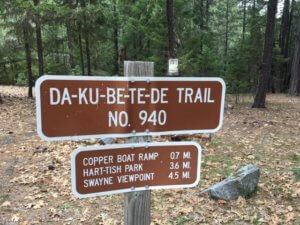Notes from Colleen’s Desk: Clearing Trails
March 11, 2020
It’s that season for me when outdoor adventure is on my mind and nearly every weekend books up with a local hike. My short term objective is to clear my mind and appreciate the amazing Southern Oregon landscapes; but my longer term purpose is to prepare for a few backpack trips that already grace my calendar.

Among those dates are two separate trips to complete the Pacific Crest Trail (PCT) in Oregon, which I am planning as solo outings. Just 40 miles to go and I can check that 460-mile venture off my bucket list. Whoop!
About 15 years ago I set out to complete the Oregon section of the PCT with my sister on what I then referred to as my 5-year day hike plan. Some aspirational goals inevitably turn into something much longer term than anticipated. Ummm, yes, it’s now 15 years later.
So I packed my water, tuna sandwich and banana in a fanny pack, donned my new lightweight rain jacket for its inaugural hike, grabbed my trekking poles and headed out on a cloudy afternoon to Applegate Lake. It’s a favorite destination but relatively new recreational asset to the region.
Congress authorized the Applegate Lake project in 1962 but its construction did not commence until 1976. Eighteen years after authorization and $96 million later, the Army Corp of Engineers completed a 988-acre reservoir for fishing, swimming, flood control, irrigation, and more.
I set out on the Da-Ku-Be-Te-De Trail for a 7.2 mile out-and-back jaunt. The trail was named after a small band of the Rogue River Indian Tribe which lived in the Applegate region dating back to 1850. This trail might even have even been a remnant of their hunting and fishing route that we are still enjoying today – 170 years later.

As I hiked along, periodically sweeping limbs off the trail with my poles, I contemplated those who went before me to create the greater 17.2 mile trek around the lake that so many hikers, bikers, and equestrians enjoy today. Naturally, my thoughts turned to how we – you, me, and every Southern Oregon citizen — are clearing trails in our day-to-day worlds, for future generations.
It seems like economic and community development initiatives take forever to come to fruition, doesn’t it? SOREDI is often asked about relocation projects we respond to and court. It simply takes time. Many of the projects we’ve worked on have been 5 plus years in the making. I can recall one project, up and operating in White City, that first contacted SOREDI in 2005. It all came together 10 years later in 2015!
We often forget about the incremental and necessary steps made by those who went before us to set the stage for a much grander vision. Certainly, trail builders need resources – tools, funding, and professionals who map out the path and anticipate navigating limbs (obstructions) along the course.
I clear the trail as I hike in order to save someone else from perhaps tripping up along the way. Here are two recent SOREDI engagements that are helping Southern Oregon communities identify the next stages for their trail building projects:
Butte Falls
Did you know that Butte Falls, with its 435 citizens, is one of the 15 jurisdictions we serve? Just a few weeks ago, SOREDI facilitated a whirlwind familiarization tour with our EDA and USDA partners to interface with 10 different communities and understand their long-term lofty goals.
Butte Falls recognizes its greatest asset is its bountiful forest. It is working with multiple state and federal partners to purchase the water falls and surrounding forest land – to preserve it as a community forest for climate resiliency, educational and economic opportunities, and recreational adventure. Read our Butte Falls community gem story here: https://soredi.org/community-gems-butte-falls-elevated-living-at-2400/
Medford
Let’s turn now to our largest community. Approaching 82,000 citizens, one might think all trails are readily cleared for the City of Medford and that it, and its neighbor Phoenix, is poised to manage the pending growth — in particular, the growth anticipated in their southeast employment and residential lands between exits 24 and 27. This is a vision that has been part of regional problem-solving process for over 15 years.
We met with city officials from both communities to understand constraints and experience the bigger picture with an on-site visit to this expansive, high potential multi-use property. While there are few limbs and rocks strewn in the path, public and private trail builders are hard at work. The Achilles heel to this project? Transportation. We are seeking assistance from EDA (potential funding resource) to add another stretch of roadway into that property that would allow access to near-term development.
Quality of place – or “placemaking” as it is referred to in the One Rogue Valley Strategy – is an important component of our region’s economic vitality. Assuring that Southern Oregon can offer the livability that attracts companies and professionals to our region, whether it is workforce housing, recreational amenities, or transit- oriented multi-use development, is not happenchance. It takes visioning, thoughtful planning, resources, trail building, and maintenance.
Many people over time constructed the full 2600-mile PCT that I love, and for which I have a trail name. It happened one section at a time. What trails will we collectively clear for our children and future generations? We may need to bend down and pick up that big rock.
Happy Trails, “Spur”
© 1987-2024 SOREDI 1311 East Barnett Road, Suite 301, Medford 97504 • Phone: (541) 773-8946 • Fax: (541) 779-0953
